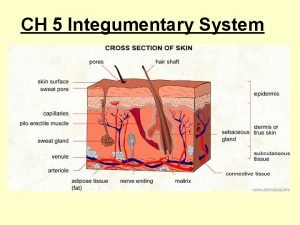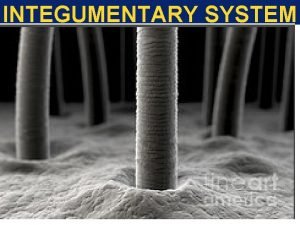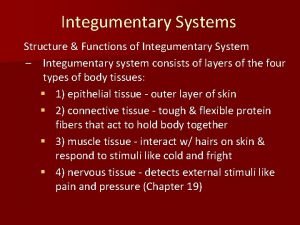Integumentary System Unit 3 Integumentary System AP Chapter
















- Slides: 16

Integumentary System Unit 3: Integumentary System A&P Chapter 5

Learning Goals Copy at TOP of page 43 1) Describe the 3 layers of the skin including the location and what structures are found in each. 2) Explain the 5 functions of the skin including how each relates to homeostasis.

1. Integumentary System The Integumentary system includes: ◦ Skin – largest organ of the body ◦ Accessory Organs: Hair Nails Serves to protect the viscera (internal organs) and regulate temperature

11. Structure of the Skin The skin is composed of 3 layers from superficial to deep:

1. Epidermis Outermost layer of skin Stratum Corneum – hard outermost layer of epidermis ◦ Produces a protein called keratin ◦ Keratinization causes hardening of dead skin cells, making skin waterproof. Stratum Basale – produces new cells of epidermis ◦ Contains Langerhans cells (for immunity) and melanocytes (make pigment to give skin color)

2. Dermis Thick layer of connective tissue containing: ◦ Dermal papillae – ridges that cause fingerprints and provide gripping surface ◦ Collagen & elastic fibers – stretching & movement ◦ Blood vessels ◦ Sensory Nerves ◦ Sebaceous Glands ◦ Hair Follicles

3. Hypodermis (Subcutaneous Layer) Deepest layer of skin Composed of loose connective tissue and adipose tissue (fat) ◦ Helps to store energy, insulate body, and provides protective padding

IV. Five Functions of the Skin 1. • • Protection Physical barrier to disease, dirt, and UV radiation Bacteria and other invaders are prevented entry by the top dead layer of skin and the acidic, oily secretion from sebaceous glands (sebum).

2. Regulates Water Loss Keratinization of the dead skin outer layer also prevents water from entering or leaving the skin, even when immersed in water. Skin works with the urinary system to sweat off some excess water.

3. Produces Vitamin D Melanocytes produce melanin to protect against harmful UV radiation from the sun and also to produce Vitamin D helps regulate the uptake of calcium by the digestive system. Calcium is needed for strong bones.

4. Gathers Sensory Information Sensory receptors are linked to the nervous system Receptors specialize in sensing ◦ Touch ◦ Pressure ◦ Pain ◦ Temperature (hot & cold) Many receptors in hands


5. Regulates Body Temperature When the body is too hot, the skin will help to release heat to cool the body temperature back to 98. 6°: ◦ Sweat ◦ Dilation of dermal blood vessels

When the body is too cold, the skin will help to raise body temperature back to 98. 6° by generating heat: ◦ Shivering (muscle contraction) ◦ Goosebumps (contraction of arector pili muscles attached to hair follicles) cause hair to trap heat ◦ Constriction of dermal blood vessels

Bad things happen when body temp. is not constant: ◦ 1. Hypothermia -Lower body temp. than normal interferes with the body’s normal functions and eventually ends in death

` 2. Hyperthermia—Higher body temp. than normal results in dehydration (from excess sweating) and heat stroke.
 Unit 3 integumentary system
Unit 3 integumentary system Chapter 6 integumentary system
Chapter 6 integumentary system Chapter 36 skeletal muscular and integumentary systems
Chapter 36 skeletal muscular and integumentary systems Cutaneous membrane
Cutaneous membrane Integumentary system vocabulary
Integumentary system vocabulary Integumentary system of swine
Integumentary system of swine Definisi sistem integumen
Definisi sistem integumen Integumentary system facts
Integumentary system facts Exercise 7 the integumentary system
Exercise 7 the integumentary system Integumentary system abbreviations
Integumentary system abbreviations Integumentary system medical terminology
Integumentary system medical terminology The integumentary system
The integumentary system Integumentary system assessment
Integumentary system assessment Integumentary system analogy
Integumentary system analogy Cat integumentary system
Cat integumentary system The integumentary system
The integumentary system Integumentary system components
Integumentary system components































